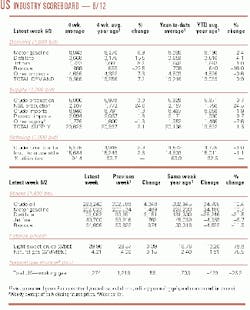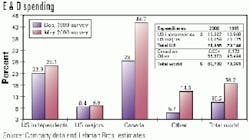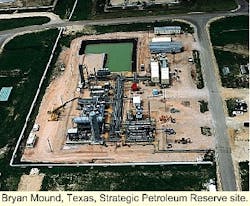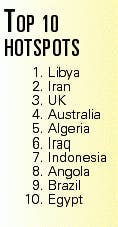Market Movement
Gas supply curtailments looming?
Could the continuing spike in gas prices spur the US government to curtail industrial gas use this winter? With natural gas storage injections and storage levels in the US both down from the peak injection season 1 year ago, natural gas prices are likely to push still higher this year.
Salomon Smith Barney contends, "We...now believe that our $3.25/ MMbtu composite spot forecast for 2000 and 2001 could prove conservative. Our biggest fear for the US economy is that events transpire such that supplies are so constrained this winter that the government steps in to limit industrial consumption in order to have adequate supplies for residential consumers for home heating purposes," the firm said.
Growing demand for power and increasingly tight supplies are causing the decline in gas stock levels; as a result, gas futures are trading above $4.40/MMbtu, and spot prices recently have hovered near $4/Mcf (see chart).
"We do not see anything on the horizon that would induce a sharp retreat in natural gas prices, which are roughly $1.77/MMbtu above 1 year ago," said Salomon Smith Barney. "In fact, factors could emerge to push natural gas prices even higher in 2000."
The US natural gas rig count reached 662 last week, up from late 1997's peak of 650. "However," said the analyst, "our analysis continues to indicate that the domestic gas rig count must exceed 800 just to return deliverability to where it stood at the beginning of last year. In the meantime, we expect [gas] demand to increase due to continued economic expansion and the addition of new, predominantly gas-fired electric generating capacity."
Storage levels lagging
Storage injections in May 2000 averaged nearly 3 bcfd lower than May 1999. "Thus...the market has become increasingly aware of the fact that storage levels are likely to enter next winter below 2,500 bcf, compared with nearly 3,000 bcf...last year," said Salomon Smith Barney.
"Consequently, the heat has been turned up to the boiling point on natural gas prices, which are now 85% higher than 1 year ago. In addition, the months of May and June are typically the peak injection months before the onset of the heavy summer cooling demand period.
"Our deliverability model-incorporating production decline rates and expected production additions from drilling activity-indicates that deliverability during...May should have been down roughly 1.8 bcfd year-over-year." Demand increases are harder to gauge, says the firm. A rough estimate, however, indicates demand could be up 2.7% vs. over last May. "This is in line with most industry expectations," said the analyst. Salomon's analysis concludes that gas prices will remain "quite strong," as have many similar studies recently.
Gasoline driving oil rally
Meanwhile, the seemingly unslakeable US thirst for gasoline continues to buoy crude oil prices near $30/bbl while markets await the next signal from OPEC ahead of the group's ministerial meeting this month.
The latest stock data report reined the price rally a bit, with API reporting last week that there was a 4.35 million bbl drop in crude stocks vs. an expected 500,000 bbl decline.
With NYMEX contracts for July and August trading at about $29/bbl, EIA reckons that WTI will remain above $28/bbl for the rest of the year.
What's more important, the OPEC crude basket marker hovered near $28/bbl last week, the threshold for OPEC to automatically boost production, provided it lasts at least 20 days.
Some traders worried about recent remarks by Venezuelan Energy Minister Al
NL Bulletin
Calgary police are gearing up for maximum security during the World Petroleum Congress, which was to get under way June 11. Police Inspector Murray Stooke says protests and violence at the recent WTO conference in Seattle suggests Calgary should plan for large-scale demonstrations and civil disobedience at the 6-day WPC.
City police will be joined by contingents from the Edmonton police force and the Royal Canadian Mounted Police.
Stooke said, on a scale of 1-10 in terms of security, Calgary has to plan for a 10.
There will be limited-access areas downtown during the conference. Merchants have been warned to take security precautions, and some oil companies in the city's center have beefed up security.
More than 2,200 delegates from 80 countries are expected to attend WPC.
null
null
null
Industry Trends
GLOBAL E&P SPENDING ON THE RISE.
A Lehman Bros. Survey of 326 firms shows companies are planning on a 18.2% increase in their worldwide E&P expenditures for 2000, vs. a 10.2% rise for 2000 budgeted in December. US E&P expenditures are budgeted to advance by 17.6% in 2000, vs. a 15.9% gain in its December 1999 survey. The firm says its results indicate that nearly $6 billion has been added to 2000 worldwide exploration budgets since December 1999, thanks to higher oil and gas prices. The US spending increase is almost entirely driven by independents. The 14 majors, however, are budgeting a similar gain for 2000 as they were in December, up 8.8% vs. 1999, compared with an increase of 8.4% reported in December.
Canadian E&P outlays are estimated to rise by a staggering 44.7% in 2000, vs. a gain of 28% expected in December 1999. Of the firms surveyed, 41% have increased estimated spending by 10% or more since December.
E&P expenditures outside Canada and the US also are slated to rise by significantly more than estimated 6 months ago, says Lehman, with 99 companies budgeting a 14.9% increase vs. a December projection of 5.7%. Budgets are pegged to average expected prices of $22.04/bbl WTI and $2.58/Mcf Henry Hub. x
THE DEEPWATER GULF OF MEXICO
is the engine driving new US energy production, says MMS. A new MMS report heralds the arrival of "the new frontier for resource management" and chronicles the unfolding of the deepwater gulf as a major world petroleum province.
There are about 7,600 active gulf leases, 48% of which are in deep water. In 1992, there were 5,600 active leases, only 27% of which were in deep water. By the end of 1999, 30 deepwater gulf fields were producing, up 30% vs. 1998.
Deepwater production will continue to rise, playing a key role in the US's national energy strategy, says MMS. In 1990, about 4% of gulf OCS oil production and less than 1% of OCS gas output was from deepwater areas. By the end of 1999, those figures had risen to more than 50% for oil and 20% for gas.
MMS says the potential for sustained, long-term activity levels in the gulf looks promising, with producible deepwater reserves estimated at about 2 billion bbl of oil and 6 tcf of gas: "Operators are developing more sophisticated and cost-efficient deepwater technology that will enable the United States to stem the tide of dependency on foreign oil."
This increase in activity also benefits society by the jobs it creates in areas ranging from computer technology to steel manufacturing, says MMS, noting that 37,000 jobs are directly dependent on the gulf's offshore oil and natural gas industry. x
Government Developments
WILL THE US WIELD THE SPR WEAPON against OPEC?
Two US senators want the Clinton administration to pledge to do just that unless OPEC hikes production at its June 21 meeting.
Sens. Charles Schumer (D-NY) and Susan Collins (R-Me.) urged US Energy Sec. Bill Richardson to tell OPEC the US would consider oil swaps from the 569 million bbl SPR. They asked Richardson "to make clear to OPEC ministers that, should they fail to honor their commitment to produce sufficient amounts of oil to ensure reasonable global prices, the US is prepared to release oil from the SPR to protect our consumers and our economy."
Under the program, companies would be allowed to draw down SPR crude and repay it with larger volumes later, the difference being the amount of oil that they bid. x
THE US-MEXICO WESTERN GAP TIFF
has been resolved.
After more than 2 years of negotiations, the US and Mexico have agreed on a division of the so-called Western Gap, a 17,190 sq km portion of the deepwater Gulf of Mexico that falls beyond their agreed maritime boundaries (see map, OGJ, Apr. 22, 1996, p. 31).
Under the treaty, to be signed at presstime last week on Pres. Zedillo's visit to Washington, DC, Mexico will end up with 62% of the gap and the US 32%, with an overlapping, 5-km-wide region remaining unassigned.
Once the treaty is approved by both countries' senates, MMS will be able to resume offering leases in the region. MMS first began offering leases in the gap in 1983 but stopped offering the blocks in 1997 following complaints from Mexico. x
IRAN IS TRYING TO FORM A GAS EXPORTERS' GROUP.
Tehran is canvassing other major gas-exporting countries with a view to inviting them to a deputy minister-level meeting in Tehran in the next 2 months, according to consultants Dresdner Kleinwort Benson Research. Included are Qatar, Algeria, Indonesia, Malaysia, Turkmenistan, Russia, and Oman. Together with Iran, these countries account for more than 60% of the world's proven gas reserves.
Dresdner Kleinwort says Tehran's objective is to exchange information on such issues as reserves, export investment plans, and market potential. Reportedly, there is no intent to try to fix gas prices or market share nor create a gas organization similar to OPEC. x
EUROPE IS GEARING UP FOR NATURAL GAS DEREGULATION.
Italy has approved a bill fixing new antitrust curbs and implementing other measures to open up its heavily monopolized natural gas market, in compliance with EU directives. Beginning January 2002, no entity will be allowed to supply more than 75% of domestic gas demand, phasing down to 61% in 2010; no single operator will be allowed to dominate more than half of the retail market; and users with consumption exceeding 200,000 cu m/year will be able to buy gas on the free market beginning in 2002. After January 2003, free-market rules will govern gas supply purchases. ENI's gas transport arm, Snam, with 90% of the market, will have to unbundle its transport, storage, and distribution businesses and be split into at least two companies. x
Meanwhile, France's Council of Ministers approved a draft law to effect the EU directive on gas market deregulation. As expected, the government was careful to accommodate leftists and insists Gaz de France will remain state-owned. Initially, deregulation, to start in mid-August, will involve only 150 French firms that each consume more than 25 million cu m/year of natural gas. That will expand to 700 firms consuming 5 million cu m/year by 2008. The same eligibility threshold will be granted to gas distributors. New gas distributors and suppliers will be able to purchase gas lines or build new ones, but there will be no third-party access to underground gas storage. x
Quick Takes
LIBYA IS THE NO. 1 EXPLORATION HOT SPOT, according to the latest survey by Robertson Research International. The changing political environment and prospects for world-class plays catapulted Libya to the top spot from the 20th position in Robertson's previous survey in 1998.
The survey asks oil companies to rate their level of interest in new global E&P ventures in 146 countries (see table).
Countries that rose notably in this year's survey vs. 1998 include Abu Dhabi, Bahrain, Dubai, and Israel. Africa also moved up to third from sixth place in regional rankings, thanks to impressive showings from such countries as Equatorial Guinea, Cameroon, and Morocco.
With respect to reentering Libya, Royal Dutch/Shell is looking to return, 9 years after it pulled out of the country. Shell was among 40 other firms at a National Oil Co.-hosted meeting last month where firms outlined terms and acreage allotments for participation in an exploration licensing round, which for the first time allows for export of gas.
China's offshore continues to sizzle.
Kerr-McGee has another oil strike in China's Bohai Bay, its third on an 850,000-acre concession. The latest well, CFD 12-1-1 on Block 05/36, was drilled to 6,804 ft in about 70 ft of water 10 miles east of the company's two recent discoveries on Block 04/36. It tested two Guantao zones that flowed a combined 2,562 b/d of 34° gravity oil. Operator Kerr-McGee has working interests of 50% in 05/36 and 81.8% in 04/36, Pendaries 15% in 05/36 and 18.2% in 04/36, and Newfield 35% in Block 05/36. x
CNOOC and Britain's Primeline Petroleum reached an agreement to transfer Primeline's stakes in two offshore oil and gas blocks in the East China Sea to CNOOC. CNOOC will process seismic and drill two exploratory wells on the blocks this year. The deal increases CNOOC's shares in Lishui 36-1 and Lishui 32-32 blocks to 85% from the original 51%, while Primeline's stakes in the blocks are down to 15% from 49%.
In other exploration action, Perupetro plans to present data on 25 blocks available for E&P contracts at the World Petroleum Congress in Calgary this week. Included are 14 offshore blocks and 11 jungle blocks in the Ucayali, Mara
Topping Transportation news, an African oil development and export scheme has received a nod from the World Bank after it approved loans to enable the construction of a 663-mile oil export pipeline from Chad to Cameroon (see Editorial, p. 25). The action will enable a group of companies led by ExxonMobil to proceed with a $3.7 billion African development project; ExxonMobil has a 40% consortium stake, Petronas 25%, and Chevron 25% (OGJ, Apr. 10, 2000, p. 40). Beginning next year, the project would entail development with about 300 wells near Doba in southern Chad and move 225,000 b/d to an offshore terminal at the Cameroon port of Kribi.
The scramble over Caspian region hydrocarbon exports continues, as BP Amoco-operator of the Shah Deniz field development in the Caspian Sea off Azerbaijan-revealed plans to export natural gas from Shah Deniz to Turkey starting as early as 2002. The plan sets up yet another hurdle for Turkmenistan and the backers of the planned Trans-Caspian Gas Pipeline (TCGP), which has been plagued by setbacks in recent months. The new export plan is a consequence of last year's surprise discovery of a huge deposit of gas at Shah Deniz, far larger than the proven oil reserves there. That turned Azerbaijan potentially into a major exporter of gas, as well as oil, to Mediterranean and Black Sea countries. The new proposal envisions supplying Turkey with 5 billion cu m/year of gas beginning in the winter of 2002-03, for a $1.3 billion first-stage period of 5 years. Deliveries can increase to as much as 16 billion cu m/year in the second stage, with Turkey acting as both buyer and transit country.
Meanwhile, Pakistani ruler Gen. Pervez Musharraf met with Turkmen Pres. Saparmurat Niyazov in Ashgabat last month to discuss proposals for a gas pipeline between their two countries. The proposed 1,600-km line from the Dauletabad fields in southern Turkmenistan to Multan, Pakistan, is considered a key future outlet for the Central Asian republic's gas reserves. The two countries hope to involve Iran in the project.
Niyazov told reporters in Ashgabat that the talks with Musharraf covered construction of a gas pipeline from Turkmenistan to Pakistan via Iran and Afghanistan. The route seems no less rife with political conflict than does the TCGP route, however.
In further transportation news, TransCanada and Westcoast will work together on plans for a pipeline to move natural gas from Alaska's Prudhoe Bay and Canada's Mackenzie Delta and Northwest Territories to Canadian and US markets. The companies are studying two options: building a line directly or through their co-owned entity, Foothills Pipe Lines, which holds a permit from US and Canadian regulators to build a line.
Expansion of the Trans-Ecuadorian trunk pipeline (SOTE) appears to be back on track. Completion of the 50,000 b/d expansion is now expected by the end of June, vs. an original start-up date of Mar. 31. SOTE's limited capacity has acted as a bottleneck for production activity in the Oriente region (OGJ, Aug. 2, 1999, p. 25). Three operators in the area have joined forces to carry out work on various portions of the line in order to gain a transport outlet for their crude production. Repsol-YPF added one pumping unit to each station at Lago Agrio, Lumbaqu
Russia leads the weekly drilling-production roundup with a supergiant offshore gas field facing potential development woes and a major US producer pulling out of its pioneering Sakhalin venture.
Gazprom unit Rosshelf plans to sign an agreement with the Kremlin by yearend to develop the massive Shtokmanovskoye natural gas field in the Barents Sea. In May, the Duma approved a bill allowing a PSC structure for developing the field. But it lies above the Arctic Circle, in 300 m of water, and at a depth of about 4 km, so there are questions about whether the gas can be tapped profitably.
Marathon, meanwhile, is pulling out of the $10 billion Sakhalin II oil and gas project off Sakhalin Island in Russia's Far East that it helped pioneer into the first PSA with the Kremlin and the first offshore production under such a deal. But after that decade-long effort, Marathon is now looking to maximize its cash flow and improve its financial flexibility. The firm signed a nonbinding letter of intent to swap its 37.5% operating interest in the Sakhalin Energy Investment Co. consortium to Shell Sakhalin Holdings, which already holds a 25% interest. In return, Marathon will acquire all of Shell UK's 28% interests in Foinaven field and associated infrastructure in the Atlantic Margin west of the Shetland Islands. Marathon also will get a 3.5% override on 100% of production in eight blocks developed by Shell in the Gulf of Mexico, including the prolific Ursa field, which reached output of 50,150 boe/d shortly after it came on stream in April 1999. x Woodside Petroleum committed $54.6 million (Aus.) for development studies and appraisal drilling on Vincent and Enfield oil discoveries in the offshore Carnarvon basin. The move may be part of a push to receive a higher takeover offer from Shell Australia. Enfield is likely to be first in line for development, with an appraisal well possible later this year. Preliminary studies indicate the field will be commercial and could be brought on stream in 2005. x Even though the joint venture was dissolved earlier this year, Spars International, a 50-50 JV of Aker Maritime and J. Ray McDermott, was awarded a spar floating production platform contract for Nansen field, operated by Kerr-McGee in the Gulf of Mexico. Spars International had bid for the contract before its dissolution (OGJ, Feb. 14, 2000, p. 32). x Kansas natural gas producers will have to refund about $750 million to consumers after the US Supreme Court declined early last week to hear an appeal of a tax refund case. BP Amoco, ExxonMobil, Oxy, and UPR asked the high court to consider the case. They and other Kansas producers owe the refunds, stemming from a FERC decision. It was the second time the Supreme Court declined to hear an appeal of the case. x An interesting deep gas play continues to shape up in California's heavy oil-prone San Joaquin Valley. Berkley Consortium is "extremely encouraged" by production tests from the East Lost Hills No. 1 well, part of the Temblor deep gas play sparked by the spectacular Bellevue No. 1 blowout in fourth quarter 1998 (OGJ, Apr. 12, 1999, p. 75). Although highly restricted, the latest well flowed gas at a rate of 12 MMcfd and more than 1,000 b/d of condensate, reports Ivanhoe Energy, which participates in an adjacent exploration JV block and plans a deep Temblor test of its own soon. Ivanhoe quoted Berkley as saying the well is capable of producing 30 MMcfd of gas plus condensate and reports the latter plans two more deep wells near its acreage.
There's a new player in the Asia-Pacific region's basic petrochemicals business.
Formosa Chemicals & Fibre, a member of Taiwan's Formosa Plastics Group, plans to switch the focus of its operations from the manufacture of textile materials to petrochemicals production. FCF has started commercial production of the first phase of its aromatics plant at FPG's new petrochemical complex. Phase 1 has capacity of 460,000 tonnes/year; Phase 2, now in development, will add another 1.2 million tonnes/year. x Meanwhile, reports circulating in Taipei indicate that Taiwan's Ministry of Economic Affairs is considering easing restrictions against investment in China by Taiwanese manufacturers of basic petrochemicals. Taiwan's petrochemical industry is welcoming reports that the new administration has decided to review the official policy of "no haste, be patient" that has barred petrochemical firms from making any significant investments in China.
In other petrochemical news from Asia this week, Royco Korea, a South Korean joint venture, has developed a technology to produce high-quality oil products from waste plastics, vinyl, and other petrochemical products, it says. The process involves thermal cracking of wastes at low temperature and pressure in the absence of oxygen, vs. traditional catalytic methods. Royco Korea says it has succeeded in recycling petrochemical waste into gasoline, light oil, heavy oil, LPG, and petrochemical feedstocks in an environmentally benign process that eliminates the need for catalysts.
In refining-marketing news, Holly is implementing a cost reduction and production efficiency program that is expected to yield an annual pretax profit gain of more than $20 million. The program includes productivity enhancements and a 10% reduction in workforce, most of which will come from Holly's Navajo Refining unit. Holly will reduce some staff through voluntary early retirement. F InterOil and Koch Petroleum Group signed a letter of interest for Koch to participate in InterOil's holding company, SP InterOil LDC, as an equity holder and supplier. The letter outlines preliminary plans for Koch to provide $3 million in combined debt and equity financing to support completion of the InterOil refinery under construction at Port Moresby, Papua New Guinea, and to enable Koch to provide crude oil supply services for InterOil. F BP Amoco will soon offer low-sulfur premium gasoline in the Birmingham, Ala., area, including Jefferson and Shelby counties. BP and Amoco service stations in the area will offer BP Super 93 and Crystal Clear Amoco Ultimate premium gasoline year-round. The fuels have an average sulfur content of 30 ppm vs. the federal requirement of 150 ppm. The move is part of BP Amoco's plan to introduce cleaner fuels in 40 cities around the world by yearend. BP Amoco has already introduced new fuels in a number of cities, including Atlanta, Chicago, Milwaukee, Detroit, London, Paris, and selected cities in Poland.








